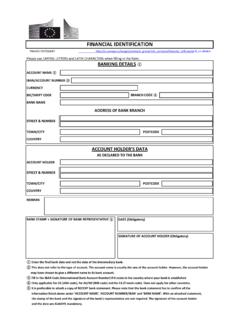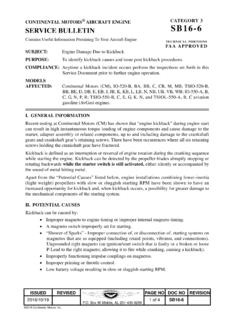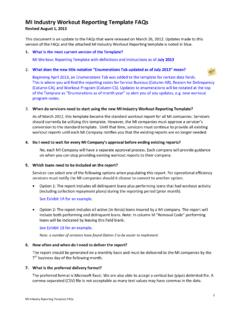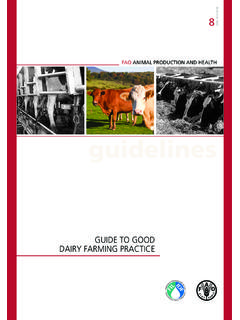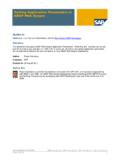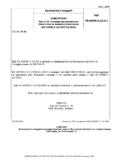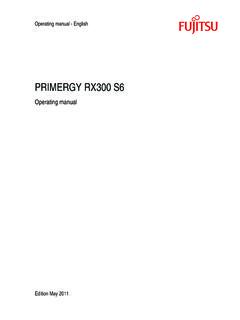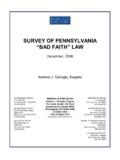Transcription of Revised monoclonal antibody (mAb) …
1 INN Working Doc. M ay 2017 Distr.: GENERAL ENGLISH ONLY Revised monoclonal antibody (mAb) nomenclature scheme Geneva, 26 May 2017 Programme on International Nonproprietary Names (INN) Technologies Standards and Norms Regulation of Medicines and other Health Technologies (RHT) Essential Medicines and Health Products (EMP) World Health Organization, Geneva World Health Organization 2017 The designations employed and the presentation of the material in this publication do not imply the expression of any opinion whatsoever on the part of the World Health Organization concerning the legal status of any country, territory, city or area or of its authorities, or concerning the delimitation of its frontiers or boundaries.
2 Dotted lines on maps represent approximate border lines for which there may not yet be full agreement. The mention of specific companies or of certain manufacturers products does not imply that they are endorsed or recommended by the World Health Organization in preference to others of a similar nature that are not mentioned. Errors and omissions excepted, the names of proprietary products are distinguished by initial capital letters. All reasonable precautions have been taken by the World Health Organization to verify the information contained in this publication.
3 However, the published material is being distributed without warranty of any kind, either expressed or implied. The responsibility for the interpretation and use of the material lies with the reader. In no event shall the World Health Organization be liable for damages arising from its use. WHO International Nonproprietary Names Programme 1 Revised monoclonal antibody (mAb) nomenclature scheme International Nonproprietary Names (INN) facilitate the identification of pharmaceutical substances or active pharmaceutical ingredients.
4 Each INN is a unique name that is globally recognized and is public property. Except for the first INN for a monoclonal antibody (mAb) (muromonab-CD3 (59)(29)), mAbs have been allocated an INN using a consistent although evolving nomenclature scheme. To date, each INN for a mAb is composed by a random/fantasy prefix, which contributes to an euphonious and distinctive name, by a substem A, which indicates the target (molecule, cell and organ) class of the mAb, by a substem B, which indicates the species on which the immunoglobulin sequence of the mAb is based, and by the stem -mab.
5 This stem is used for all molecules which contain an immunoglobulin variable domain, which binds to a defined target. This includes intact immunoglobulins of all classes, fragments such as Fab and smaller molecules such as single-chain variable fragments (scFv). This nomenclature scheme has been used since the early 1990s to allocate INN to over five hundred mAbs. However, more recently concerns have been raised with the INN nomenclature scheme for mAbs. Firstly, the number of applications for INN for mAbs has been increasing significantly, with the outcome that identifying new, distinct, pronounceable-by-all and not too long INN is becoming very difficult.
6 Secondly, the substem B that indicates the species has been used as a marketing tool; some particular infixes compared to others have been considered better and with an advantageous immunogenicity profile than some other infixes, even though scientific data does not support it. In view of these concerns, the INN Expert Group has decided to revise the nomenclature scheme that assigns INN for mAbs. A broad consultative process has taken place, both during the INN Consultations (see the Executive Summaries ) and ad-hoc meetings with third parties and national nomenclature bodies.
7 As a result of this process, during the 64th INN Consultation, the INN Expert Group recommended to discontinue the substem B (source infix), except the pre-substem -vet- for veterinary use, which will be included in substem A list. This will ease the difficulty in finding new INN free of conflicts and not liable to be confused with names already in use. This could allow a longer fantasy prefix , which should lead to greater diversity in possible INN for mAbs. In some cases, it may be necessary to alter the target infix to avoid confusion between the old and new INN nomenclature scheme, for WHO International Nonproprietary Names Programme 2 example -t(u)- (for tumour) will no longer be used and it will be replaced by -ta- (for more examples, kindly see Table 2).
8 It is reasoned that the description at the level of publication will provide more extensive information about the precise origin of the mAbs. Indeed, the information, regarding the species on which the immunoglobulin sequence of the mAb is based, will continue to be included in the definition of INN for mAbs. Table 1: Pre vious mAb nome nclature s che me . Pre fix: Subs te m A: target class Subs te m B: the species Ste m: random -b(a)- bacterial -am(i)- serum amyloid protein (SAP)/amyloidosis (pre-substem) -c(i)- cardiovascular -f(u)- fungal -gr(o)- skeletal muscle mass related growth factors and receptors (pre-substem) -k (i)- interleukin -l(i)- immunomodulating -n(e)- neural -s(o)- bone -tox(a)- toxin -t(u)- tumour -v(i)- viral -a- rat -axo- rat-mouse (pre-substem) -e- hamster -i- primate -o- mouse -u- human -vet- veterinary use (pre-substem)
9 -xi- chimeric -xizu- chimeric-humanized -zu- humanized -mab Table 2: Ne w mAb nome nclature s che me . Pre fix: Subs te m A*: target class Ste m: random -ba- bacterial -ami- serum amyloid protein (SAP)/amyloidosis (pre-substem) -ci- cardiovascular -fung- fungal -gros- skeletal muscle mass related growth factors and receptors (pre-substem) -ki- interleukin -li- immunomodulating -ne- neural -os- bone -toxa- toxin -ta- tumour -vet- veterinary use (pre-stem) -vi- viral -mab * The substem A is currently under revision.
10










